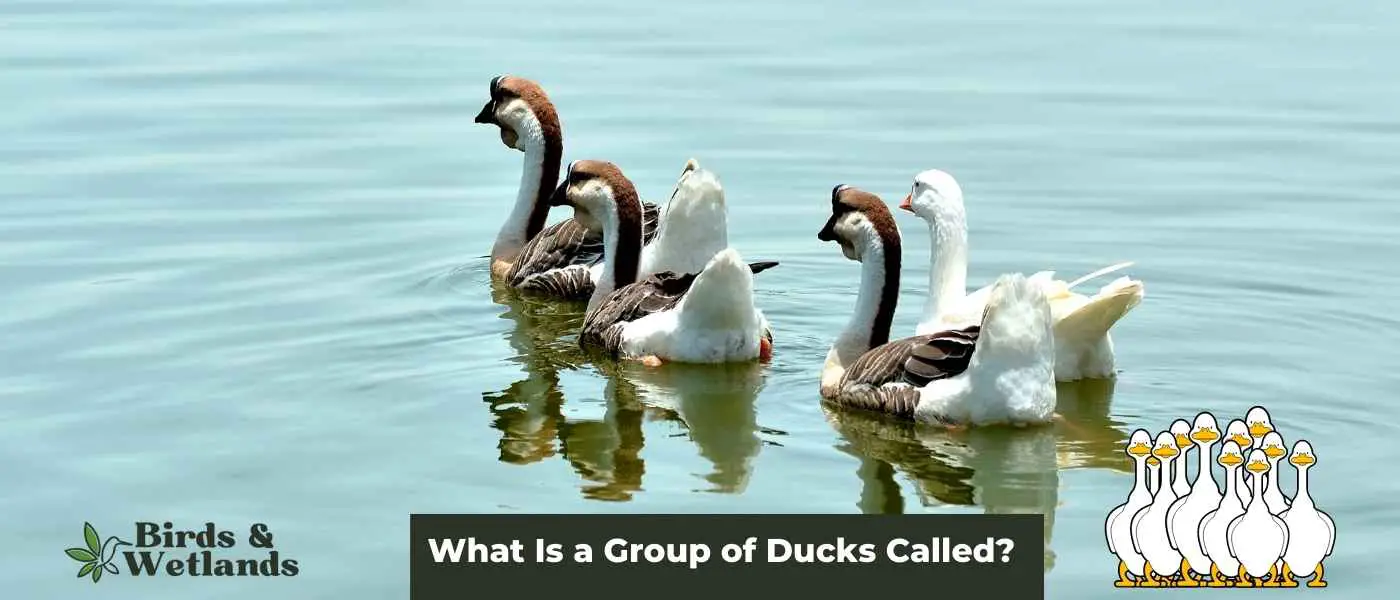Have you every looked at a flock of ducks and wondered, what is a group of ducks called?
Wonder no more!
A group of ducks can be called a raft, team, or paddling when they are in water. When they are on land or in flight, a group of ducks is commonly referred to as a flock. These terms are used to describe the social and collective behavior of ducks, which are often found in groups for safety and social interaction.
Key Takeaways on What Is a Group of Ducks Called
Depending on their actions, a group of ducks may be referred to as a raft, flock, or brood, among other terms.
A flock of ducks consists of twenty to thousands of individual ducks.
A group of ducks on the ground can be called a waddling, badelyng or badling.
What Is a Group of Flying Ducks Called?
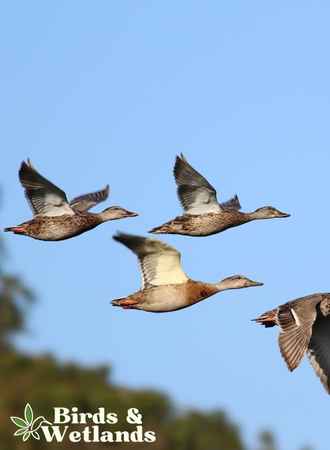
A group of ducks flying together is known as a skein, flight flock, or team. The word flock is the most commonly used to refer to a group of ducks regardless of where they are and what they are doing. While these are all standard terminology, numerous other terms characterize various groups of ducks on the wing. Raft, herd, and coil are a few examples.
Whatever you call flying ducks, one thing is certain — nothing beats witnessing a lovely flock of ducks gently flying over the sky against a vibrant blue backdrop.
Whether you’re a birdwatcher or simply appreciate watching nature at its best, seeing a flock of ducks in flight is an unforgettable experience.
What Is a Group of Swimming Ducks Called?
Ducks are basically swimmers and social birds with an affinity to water. A group of swimming ducks is called raft. While different species of duck may behave fairly differently in social groupings, a raft is basically a group of ducks gathered together on the water.
Swimming in close formation and tightly packed together, numerous species of ducks can navigate currents and wind patterns with better precision over long distances.
In addition to facilitating their navigation, a raft enables ducks to hunt for food more efficiently. A typical duck’s diet consists of aquatic plants, insects, grains and fish. Since some types of prey, such as aquatic invertebrates, are only found in certain areas of the water, keeping so many eyes on the water helps ducks locate the finest hunting grounds.
Similarly, living close together sometimes doesn’t include their own species, allowing them to avoid potential predators like other birds and larger fish species.
However, perhaps most critically, a raft protects from danger. If one or two ducks are startled by an unexpected sound while swimming alone in the water, they could become easy prey for larger predators and other animals.
However, keeping together in a close-knit community can amplify their defenses and better protect themselves from any potential threat.
What Is a Group of Walking Ducks Called?
When you watch a group of walking ducks, you are basically watching flock of ducks. Ducks flock can also be applied to a group of ducks swimming in the water or flying together. Typically, this aggregation occurs while these birds search for food in a particular location. Ducks are sociable birds. All they need is a lake and other ducks to live with.
In contrast, a “brace of ducks” often refers to two or three ducks together. These smaller groups may emerge when one duck attracts the attention and interest of another or when a parent and offspring pair off while going about their everyday activities.
Regardless of what a group of ducks walking together is called, these smaller groups of ducks have the same objective — to be secure while enjoying all that nature has to offer.
What Is a Small Group of Ducks Called?
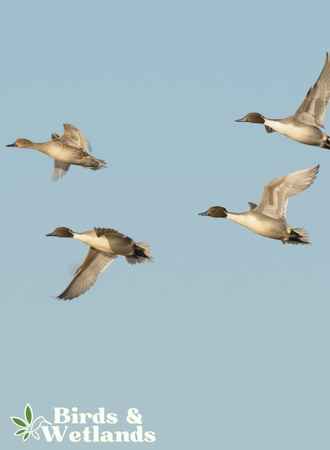
Ducks are known to form large flocks. But that is not always the case. In some cases, you can see three or five ducks in a group which is called duck paddle if they are swimming or doping ducks if they are diving.
How Many Ducks Are in a Flock?
Several factors determine the number of ducks in a flock. Ultimately, it all comes down to these birds’ innate behavior. Ducks are gregarious animals that appreciate the company of other species members. This indicates that they frequently congregate for both hunting and social functions. They make loud noises to warn others when they spot a potential predator.
There are several distinct sorts of duck flocks in the wild. Some populations lean toward smaller flocks, with as few as ten or twenty members per group, whereas others may have several hundred ducks in a single flock. Depending on where ducks reside, these group sizes are influenced by food availability, predator prevalence, and accessible habitat space.
The term flock simply refers to a group of ducks, usually implying more than one duck. The number of ducks in a flock varies from one flock to another — a flock can have as fewer as two ducks but can be as many as thousands of ducks.
Generally, wild ducks gather in groups and form flocks of ten to twenty ducks. But this number can go upwards to hundreds, even thousands. This is particularly true during their annual winter migration.
Comparatively, domestic ducks are observed in groups of three to fifteen. Two or three ducks make up the smallest flocks of ducks kept as pets.
Both wild and domesticated ducks form groups, live in flocks and follow their elder ducks’ rules.
Unfortunately, living in large groups or flocks has many disadvantages. For instance, a contagious disease such as Avian cholera can spread easily when one of the birds becomes afflicted. Avian cholera is a disease that can be transmitted from bird-to-bird contact or ingestion of contaminated food and water.
What Is a Large Group of Baby Ducks Called?
A bunch of ducklings is referred to as a brood. This common collective noun denotes a group of young and immature ducklings. Groups of young ducks are typically quite active and energetic, continuously swimming and searching for food wherever they go.
While some bird species only have one or two chicks at a time, ducks can have much bigger broods, including numerous ducklings. In addition, most ducks lay multiple eggs in a season, allowing for the production of numerous broods within a single breeding season.
What Is a Group of Ducks Called Based on Their Common Characteristics?
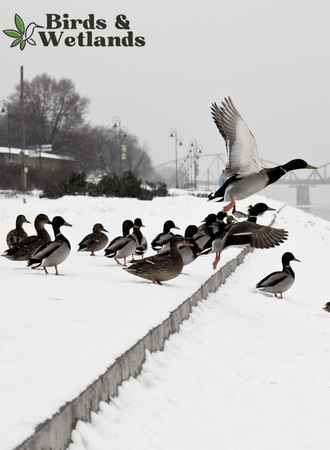
Dabbling ducks, such as mallards and teals, spend most of their time at the surface of ponds and marshes, grazing on the vegetation that grows there. Dabbling ducks, renowned for their dexterous feeding style, flick the water with their bills and use their long, flexible necks to dip into the water while keeping most of their bodies above the surface.
Diving ducks, such as goldeneye ducks and mergansers, constitute another duck species category. These aquatic birds are distinguished by their ability to dive underwater and torpedo-like bodies, which enable them to hunt fish and crustaceans by diving beneath the surface of bodies of water. Diving ducks have thinner bills than dabbling ducks, allowing them to capture slippery prey below the surface quickly.
Perching ducks are the final type of duck. Perching ducks are frequently spotted on tree trunks or moist reeds near shorelines, as their name suggests. Although not as well adapted for swimming as other ducks, perching ducks have strong legs that allow them to forage for food, such as insects and seeds, on land environments near bodies of water.
Why Do Ducks and Other Birds Fly Together?
Ducks and other gregarious birds fly together in groups or flocks and develop deep social contacts. When observing large groups of ducks flying across the sky, it can be tempting to think that they are simply migrating or simply flying for pleasure. However, there is a significantly more significant reason why birds migrate in a flying group.
By forming a flight flock, ducks and different birds limit their vulnerability to predation, allowing them to reach their objective safely. In a flock, more birds can quickly spot potential predators.
And larger groups also ensure that everyone continues in the correct direction, decreasing the likelihood of becoming lost or separated. Taking advantage of air currents or thermal layers enables birds to travel further with less effort when they fly in groups.
What Do You Call a Group of Mallard Ducks?
Depending on who you ask, a group of mallards is known by various names. A sword, a suite, and a fistful are examples of common collective nouns.
The male Mallard is known for its glossy green head. Because Mallard ducks are so common and versatile, they are also more creative or odd terms, such as daggle, knob, and waddling.
The social aspect of these ducks is intriguing and multidimensional, whether you watch them floating overhead in vast groups or huddling together for warmth in the winter months.
In reality, several groups have sought to develop official guidelines for determining which name should be used for a specific number of Mallard ducks over the years.
What Is a Group of Wood Ducks Called?
There are different collective nouns that are used to refer to a group of wood ducks but the most common of these nouns are flock, team and flight of ducks. Regardless of the term, wood ducks are known for traveling and living in large flocks. Not only does this provide safety and protection for the ducks, but it also helps them to save energy and optimize their survival in difficult conditions. Indeed, flocks provide an effective means for regrouping after a hazardous escape attempt or as part of group hunts for food.
What Is a Group of Wild Ducks Called?
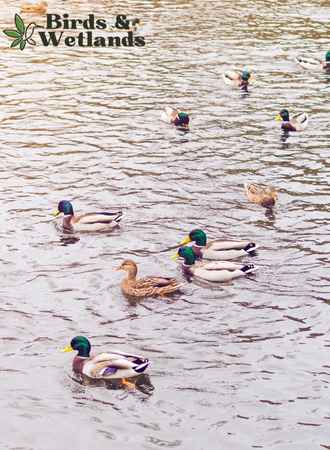
Frequently, a group of wild ducks is referred to as a raft or paddling of ducks. This is because these birds are most usually observed in water, where their swimming abilities enable them to create cohesive flocks that move across the surface of lakes and rivers with relative ease.
This cooperative activity not only aids ducks in avoiding potential predators but also enables them to pool their resources for feeding and nest-building. This coordinated effort also serves an essential social role, allowing individual ducks to form strong bonds among the larger flock.
Additional Duck Terminology and Facts
A male duck is called a drake, while the female or mother duck is called hen.
A hen will line her nest with soft down feathers she plucks from her own breast when building it.
Ducks are known for popping a lot. In fact, a duck family will produce 365,000 droppings annually, all of which will sink to the bottom of the river, lake or pond.
Even if a duck dives underwater, its downy underlayer of feathers will remain dry due to the duck’s feathers being waterproof.
Domestic ducks have descended from either the Mallard or Muscovy ducks. These waterfowl have been domesticated for centuries either as pet ducks or farm animals.
A domestic duck can be referred to as a wild duck but not the other way around.
A duck’s walk is referred to as a waddle.
A wild duck is a non-domesticated duck that can barely survive if held in captivity.

